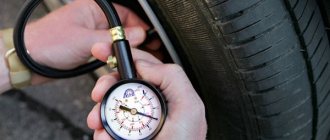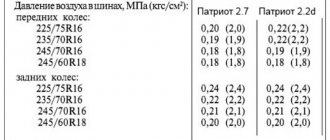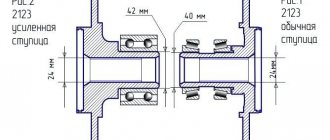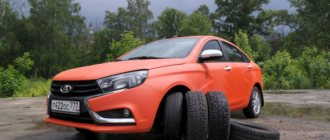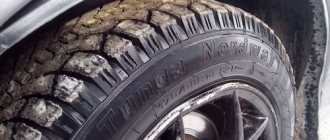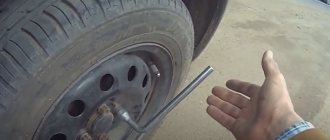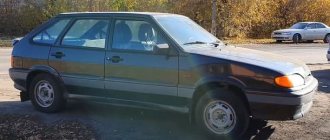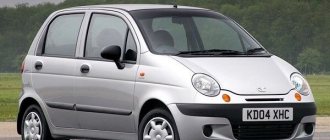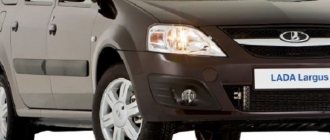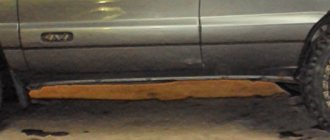The importance of maintaining the correct pressure in Chevrolet Niva tires is one of the most underestimated parameters by car owners. This is important because the pressure maintains a range of performance characteristics:
- car control stability;
- ride stability;
- braking distance within the design;
- specified trajectory of movement;
- uniform wear of the treadmill, due to which the service life of the tires is maintained at the proper level;
- integrity of the side surfaces;
- volumes of fuel consumption not higher than those specified in production.
The Niva manufacturer recommends that the pressure on both the front and rear axles reach 1.9 bar. The recommendation applies to the sizes of 15-inch tubeless tires 205/70, 205/75 and 16-inch 215/65.
In the case of off-road driving, factory recommendations allow the indicator to be reduced to one and a half bar. In some cases, car owners themselves increase the pressure to 2 or 2.2 bar for driving on the highway. The manufacturer indicates that pressure above two makes the ride harsher and less comfortable.
Methods and frequency of measuring air pressure in Chevrolet Niva tires
Tire pressure is measured using special devices and at specified intervals. The main measuring device is a pressure gauge. There are two categories of this device:
The first ones are distinguished by the fact that they have a mechanical drive in combination with a dial indicator. The disadvantage is the rather high level of error, which increases in the cold season. This is due to temperature deformation. In connection with this, mechanical pressure gauges are used in the cold only as an aid until the opportunity to visit a service station arises. But this disadvantage is offset by the long service life and the absence of the need for a power source.
Checking tire pressure before each long trip is a mandatory step to ensure the safe operation of the vehicle. Do the necessary actions in a certain sequence:
- let the car sit for at least three hours;
- check that the tires are cold;
- connect the pressure gauge and take measurements as indicated in the instructions for it;
- check the result with the table of acceptable values;
- recheck the data after a half-hour pause.
Evidence of a puncture will be a decrease in readings between two measurements. The absence of any changes indicates that the situation is normal.
Experts recommend checking the pressure after driving. This must be done two and a half or three hours after stopping. Thanks to this additional measurement, you can eliminate the possibility of a puncture formed during the trip. It is necessary to measure data not only on the installed tires, but also on the one that is used as a spare.
Instruments for checking the degree of pumping
For cars such as the Chevrolet Niva, maintaining this parameter is especially important. The center of gravity of this car is high, and the car cannot be called stable, especially during emergency maneuvers. It is impossible to measure the degree of air compression in a tire without special measuring instruments.
Pressure gauges are used for these purposes. They are divided into two categories that differ structurally:
- Mechanical pressure gauge. A device for measuring tire pressure, having a mechanical drive and a dial indicator. Has a significant degree of error, long service life, does not require a power source.
- Electronic pressure gauge. Electronic type device with a screen for displaying measurement data. It is powered by an internal power source; when used correctly, the error tends to zero.
Important: The error of devices of the first type is greater in winter than in summer due to temperature deformations of mechanical parts. In cold weather, it is recommended to use only to get to the garage or service station. The disadvantage of electronic pressure gauges is that the battery can run out at the most inopportune moment.
What pressure should be in the tires of a Niva Chevrolet car?
The main differences for tires of the same size are related to the time of year when they are used. So, in winter the surface of the trails is often quite slippery. At the same time, the elasticity of the rubber increases. This results in a pressure reduction of 0.2 or 0.3 bar being allowed. Lower tire pressures allow you to increase the contact patch between the tire and the road, which has a positive effect on the quality of grip.
Tire pressures are lower than recommended in case of extreme off-road conditions or if the car is stuck in the snow. In the second case, a decrease is permissible up to 1.2 atmospheres. Thanks to such a low injection, it will be easier for the Chevy to drive onto hard surfaces, but as soon as this happens, the pressure must be brought up to normal for this time of year. If the car is stuck off-road, then for mud tires, when setting the required pressure level, tread wear is also taken into account.
These recommendations work for all tire sizes, including the most popular 205/75/R15, 205/70/R15 and 215/65/R16
Tire pressure table for Chevrolet Niva in winter and summer
Table of recommended pressures for tires with the most common diameter p15, as well as other sizes:
| Diameter | Standard size | Recommended pressure |
| R15 | 205/70 95T | 1,9 |
| 205/70 95Q M+S | 1,9 | |
| 205/75 97T | 1,9 | |
| 205/75 97Q M+S | 1,9 | |
| 215/75 100Q | 1,8 | |
| R16 | 215/65 98Н | 1,9 |
| 215/65 98Q M+S | 1,9 |
Road conditions significantly affect the permissible deviations from the recommended pressure indicated in the table for various tire radii. So, if the Niva Chevy is driving through mud or loose snow, then the optimal solution would be to reduce it to 1.2-1.5 atmospheres. But it is worth considering that such a low pressure at the wheel can lead to its disassembly. Therefore, the ride should be relatively smooth, without sudden jerks.
VIDEO: KAMA Flame tires review of ALL SEASON RUBBER IN 2018!!!
Fuel filter KAMAZ coarse cleaning fgot in sb pl270x with key price
How to install clutch discs correctly on KAMAZ video
Standard time standards for repairs of KAMAZ trucks
KAMAZ gearbox diagram with divider repair diagram photo
Moscow Age: Ufa Age: VAZ 1.8 carb Kama Flame slides on the ice! Ryazan Age: St. Petersburg Age: Andrey Reg.: Vinnitsa, Kyiv Age: Dnepropetrovsk, Ukraine Age: Mikhail Sokolov means both front and back have the same pressure. Mikhail Sokolov:.
Free online consultation with an Auto Mechanic:
All wheels. The larger number leans toward 2. Added after 6 minutes 11 seconds: Hello, colleagues! I see that the manometric topic has not lost its relevance since its beginning, the first posts here are from Mr. So: Everything is said there. And for the money everything is pretty decent, something like from to - on Wed. Now I’m just puzzled by the problem of such an acquisition. I’ll find out exactly the magazine or send you a link. But if you're interested, you can see for yourself on zr.
So what if we are fools? But we will never be bored!
Consequences of incorrect tire pressure
Neglecting the pressure in the wheels of a Chevrolet Niva can lead to a number of negative consequences for both the car itself and its owner. The most significant of them:
- premature wear of the chassis with inevitable failure of one or another of its parts - caused by increased load;
- if the pressure is too low, fuel consumption increases, which directly depends on the area of contact of the rubber with the road;
- an excessively widened tread prevents the car from moving normally;
- to overcome obstacles, the motor is forced to develop more power;
- if the pressure is too high, then due to poor traction the risk of getting into an accident increases;
- lateral tire wear due to flat tires;
- accelerated tire wear on hard surfaces is the result of low pressure.
Timely adjustment of the pressure level, in accordance with the recommendations specified in this article, will help to avoid all these problems.
The tire pressure of any car is not just the key to a comfortable ride. Maintaining the correct level of air in the tires of any vehicle is, first of all, the safety of the driver and passengers on the road.
Also, incorrect tire pressure can cause problems in the operation of the entire chassis and wheelbase of the vehicle. Therefore, this indicator should be monitored regularly. Next, we will consider how this should be done on a Chevrolet Niva car, and what the consequences of incorrect indicators are.
Car tire pressure monitoring
What tires can be installed instead of the factory ones?
The reasons for installing tires with other sizes may be different, for example, the driver wants to increase the speed of the car, or increase its maneuverability and weight load. It all depends on the conditions in which you will operate the car. An option to replace factory tires in the summer can be 215/75R15 tires, and for a wheel with a diameter of R16 in the winter, 215/65R16.
Usually, after indicating the size, the tire is marked with a load index and a speed index. The speed index is indicated by Latin letters, the load index is indicated by a number. For a Chevrolet Niva, you need to install a tire with the Q index, which means the maximum safe speed on such tires is no more than 160 kg. There is no point in installing a tire with a high speed index, since the car engine simply will not support it.
When selecting a tire, you must strictly adhere to the seat diameter. You cannot put an R16 tire on an R15 rim, or vice versa, an R15 tire on an R16 rim. In the first case, the rubber will simply dangle on the disk, and in the second case, it may burst during installation or while driving.
Measuring methods
It is impossible to determine the amount of air in tires without special instruments. Outwardly, it turns out to notice only some deformations, the cause of which was incorrect pressure. As a result, some depression may appear on the rubber itself and the tread pattern may change.
You can measure tire pressure on a Chevrolet Niva only using pressure gauges. There are two types of such devices:
- mechanical (switch);
- electronic.
Electronic pressure gauge for cars
The percentage of error for mechanical pressure gauges is higher, but not significant. In everyday life, they can be used with the same success as their electronic counterparts. Electric pressure gauges provide the most accurate results. The error indicator in this case is no more than 0.05 bar. Today this is the most accurate device for measuring tire pressure not only on Niva, but also on other cars.
It should also be noted that in winter the tire pressure level can be more or less accurately measured only with an electronic pressure gauge.
Measuring devices
A pressure gauge is used to measure tire pressure.
There are three types of pressure gauges:
The dial pressure gauge is most often used, as it is the most reliable and cheapest. It works on the basis of a special spring. The same spring is the “Achilles heel” of the pressure gauge; if the device is hit or dropped, it can break.
A mechanical pressure gauge is more reliable. It is based on a cylindrical spring. However, this pressure gauge shows the greatest measurement errors.
An electronic pressure gauge has the greatest accuracy. True, very cheap devices lack this quality. Like any electronics, it is less reliable compared to its mechanical counterparts.
Important . The check is carried out on cold wheels. This means that the machine must be left at rest for at least 3 hours.
Relieving pressure correctly
In order for the readings to be accurate, you need to remove the pressure correctly. This should be done this way:
- tires must be unheated;
- for the last 3 hours before measurement, the car should be at rest or drive no more than 1.5 kilometers;
- Measurements must be taken on all four wheels and the spare wheel.
Only in this case can the readings from the pressure gauge be considered correct.
Table of values for the required tire pressure level for the Chevrolet Niva:
| Automobile model | Years of production | Tire size | Front tire pressure (atm./psi) | Rear tire pressure (atm./psi) |
| Chevrolet Niva | 2004—2014 | 205/75 R15 | 2,1/30 | 2,1/30 |
| Chevrolet Niva | 2004—2014 | 205/70 R15 | 2,1/30 | 2,1/30 |
| Chevrolet Niva | 2004—2014 | 215/65 R16 | 2,2/31 | 2,2/31 |
The pressure standards for Niva wheels 2121 or 21214 must be indicated on a special metal plate. As a rule, it is attached to the door on the driver's seat side. If for some reason there is none, you can look at the data online. But in this case, it is better to take into account the readings only approximately.
You should also pay attention to the fact that the amount of air in the rear tires should be about 0.3-0.5 bar more. This is due to the fact that the load on the rear axle of the wheel is always greater than on the front.
Answers (1)
According to the instructions from the manufacturer, the tire pressure should be 1.9 bar on the front and rear axles with tires measuring 205/70 R15, 205/75 R15, and 215/65 R16. For off-road use, the pressure can be “lowered” to 1-1.5 bar, but should not be lower. For the track, some owners increase it specifically to 2.0-2.2. And at many tire shops they pump it up as standard - 2.0 b/atmo. But above two is always tougher than 1.8-1.9 and less comfortable.
Source avtoexperts.ru
Every car owner knows that the air in tires must be at a certain pressure.
The pressure standard is determined by the manufacturer. Deviation from which significantly affects the quality and safety of movement in a car.
Consequences of incorrect pressure
In addition, if the pressure is incorrect, the chassis and wheelbase of the Niva 2121 or 21214 are destroyed. The following negative factors may also arise:
- fuel consumption will increase significantly (on average by 1.5-2 liters);
- tires will become deformed;
- There will be a possibility that the tire will burst while driving, which could lead to an accident.
All these negative factors can be avoided if you timely measure the pressure in Niva 21214 or 2121. By the way, this applies to any vehicle.
Your safety on the road while driving depends on the pressure in the tires of your Niva 2121. Therefore, you should not neglect such checks - they need to be carried out regularly (on your own or at a service station).
In addition, in addition to safety while driving, if tire pressure standards are not observed, the vehicle's chassis and wheelbase wear out much faster.
Reading time: 6 minutes
One of the important aspects of a safe ride is the correct tire pressure. Car enthusiasts often do not pay special attention to such a small thing as pressure. But this is far from a trifle, and with an inappropriate wheel inflation index, not only the car, but also the passengers can suffer.
Sometimes even experienced drivers do not know exactly how many atmospheres should be in the tires of their own car. Each car has its own indicators regarding the optimal tire pressure. And they may differ on the front and rear wheels. This is explained by the fact that when the car is loaded, more load is placed on the rear tires. Therefore, the pressure in them is usually higher than in the front ones.
Inflated wheel
Each vehicle undergoes many tests before reaching auto stores. And among them there are tests for optimal tire pressure. Each individual car has its own standards regarding the amount of atmospheres in the wheel. And they are indicated by the manufacturer on the gas tank hatch or on the driver's door. It clearly states the optimal indicators for minimum and maximum vehicle load. It is these parameters that vehicle owners need to adhere to.
Why is it necessary to control?
Reduced or increased air content leads to a change in the contact surface of the tires with the road surface. This leads to various consequences.
- road grip decreases
- road stability decreases
- tire tread wears off unevenly, more in the middle
- the shock-absorbing properties of the wheel are reduced
- the risk of damaging the tires when falling into a hole increases
- braking distance increases
- increased contact area with asphalt
- fuel consumption increases
- the tread wears out faster and unevenly, more at the edges
- car control deteriorates
- decreased stability when turning and changing lanes at high speed
- the chance of tire and rim damage increases when a wheel falls into a hole
The greatest danger comes from different pressures in all wheels. While driving, the vehicle “steers” towards the wheel with the lowest value.
Tire pressure "Niva Chevrolet"
This is because the car has a high center of gravity. It is difficult to control in an emergency situation, such as a sharp turn, as it is not very stable. Therefore, it is necessary to monitor and check the amount of atmosphere in a tire once a week. For such measurements there are special pressure gauges, which are:
They don't need a power source, which is another plus. Electronic devices have virtually no errors, but are dependent on batteries that can run out at the wrong time. Rack and pinion pressure gauges are considered very inconvenient to use, but they do not allow for inaccuracies. Few people use them because they are very fragile.
The pressure in the Chevrolet Niva wheels on the front and rear axles is no different. For example, the optimal indicators correspond to 2.1 atmospheres, and at maximum load they increase to 3.0. However, these standards may vary depending on the radius of the wheel. In winter, you can reduce the pressure slightly, by about 0.2 bar. This helps the hard rubber handle the road and increase the contact patch area. In summer, atmospheric parameters should be kept within the car manufacturer's recommendations.
Chevrolet Spark tire pressure indicators
Many people consider the Chevrolet Spark to be a toy car, but this is not at all true. It doesn’t have much power, but it can quickly dodge at a traffic light. The recommended tire size for it is from R13 to R15. In summer, you need to inflate all wheels to 2.2 Bar, and in winter to 2.1 Bar. If you do not adhere to such indicators, then if the car is under-inflated, it will be difficult to control, and it will skid when turning, especially in winter.
In such a situation, underinflated tires will literally drive sideways, and fuel consumption will increase significantly. When the number of atmospheres does not match the recommended standards, this can lead to:
- tread wear;
- premature tire wear;
- deterioration of controllability;
- failure of the car's chassis;
- excessive fuel consumption.
So it’s better to adhere to these standards than to spend money on new spare parts and tires.
The machine must be at rest for at least three hours for the pressure readings to become clear. As the tire heats up, the volume of air inside it also increases, so for accurate readings you need to take measurements on cold tires.
Tire pressure in Chevrolet Aveo
In the case of a Chevrolet Aveo, tire pressure varies significantly depending on the tire size. So, for example, in wheels R13-R14 the number of atmospheres should be 2.1 Bar. And with increased load it increases to 3.0 Bar. But tires of size R15-R16 require an increase in indicators to 2.5 Bar at minimum load, and up to 3.5 Bar at maximum.
In the summer, hot weather causes the air to heat up and tire pressure to increase slightly. Therefore, you can underinflate the wheels by about 0.2 Bar. Before every long trip, it is worth checking the indicators in all four wheels and in the spare tire.
This device measures both the pressure and temperature of the air inside the tire. All results are displayed on the electronic panel. And if the sensor notices a violation of the amount of atmospheres in any tire, the system notifies the owner about this with a sound or light signal.
If you don’t want to spend a lot of money on such a system, you can purchase mechanical controllers that screw onto a nipple. As the pressure drops, the color of the cap changes. This device does not notify of violations of standards. Only visual control is possible behind it.
Pressure meter
Check frequency
Often the driver remembers the tire pressure only 2 times a year - when changing tires at a tire shop before the next summer or winter season.
However, the wheel is not a completely sealed device and over time, depending on the degree of wear of the rubber, air may escape. Ideally, you should check the amount of air before each trip. But the most optimal control mode would be to check once every 2-3 weeks and before long trips.
In spring and autumn, when sudden temperature changes are possible, it is better to check more often. When the temperature changes by 10˚C, the air pressure changes by at least 0.1 bar.
Pressure indicators "Lacetti" Hatchback
All experienced motorists recommend following the manufacturer's recommendations regarding optimal tire pressure. If the wheels on the car are factory, then there is no need to deviate from the provided standards. But if the car was refitted with other tires of a different size, then the indicators may vary slightly. It all depends on the recommendations of the tire manufacturers.
If no more than four people travel in a car, then the number of atmospheres should be 2.1 bar. And when the car is fully loaded, you need to pump it up to 2.4 Bar. Such brands of cars are often produced with a built-in pressure control system. Therefore, it is much easier to follow the standards, since all measurements are taken automatically.
Consequences of incorrect tire pressure
Features of pumping in winter
Since in winter the tire’s grip patch should be slightly larger than in summer, you should slightly reduce the pressure in the wheels of your Niva 2121 or 21214. This is due to the fact that the road surface is most often covered with ice. The larger the adhesion area, the lower the risk of an accident. Under the weight of the car, the tire “sags”, the tread opens up more, which ensures tight traction of the wheel even with bare ice and at high speed.
Standard tire pressure for Niva 2121 and 21214
Chevrolet Orlando tire pressure
This brand of car has a fairly large size and weight, so the atmosphere indicators in tires are higher than those of the previous models under consideration. The manufacturer recommends maintaining a value of 2.4 Bar in all four wheels. And when the load increases, raise it to 2.7 Bar.
Therefore, on forums you can often find advice from drivers who recommend pumping the wheels to just 2.0 bar. With such indicators, the car drives smoother and there is no discomfort while driving. Convenience may be higher, but tire wear still increases. And fuel consumption will increase slightly.
It is necessary to monitor the pressure in your tires regularly. Failure to comply with the standards specified by the car manufacturer can affect not only the wear of car parts, but also the safety of the driver and his passengers. You need to be especially careful when choosing a pressure gauge. It is better to purchase a more expensive option with a high accuracy class than to later suffer from incorrect readings from a cheap model.
